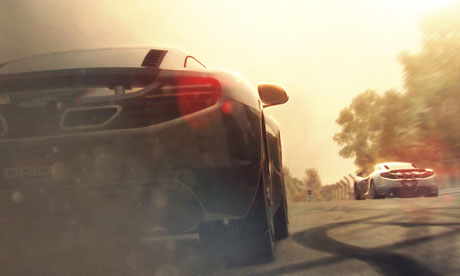Grid 2 cleaves a compromise route between realism and an arcade driving experience. Trading paint with other cars is encouraged, and can be an occasional source of tactical advantage, but an unsympathetic damage mechanic can reduce your ride to a leftwards-trending hulk with the power of a pedalo.
Enemy AIs have grown markedly angrier since Grid, and are happy to plough headlong into your flank if you corner inexpertly. The WSR pits you against regular rivals: after having tangled more than once with expert driver, narrative antagonist, and all-round bête noir Harrison Carter, you may find yourself fixated on committing vehicular manslaughter.
 Grid 2: trading paint is encouraged
Grid 2: trading paint is encouraged Racing modes include Race, which, your utterly unironic in-house technical assistant informs you, involves finishing the race before your opponents, one-on-ones; Elimination, where the last-placed car each lap gets axed; Checkpoint, which capitalises on nostalgia for the era of arcade games by forcing you to win extra time by hitting checkpoints; a number of bonus modes, including Overtake, where you must overtake a fleet of ambling pickups car-by-car without crashing to gain points; and Endurance, which is really just a misleadingly named variant of Race.
Grid 2 boasts LiveRoutes, which are procedurally generated tracks where your course varies as you drive it. Much more fun, however, is getting to know a course, and comparing performances across consecutive attempts at the same corner. As any regular Top Gear viewer will tell you: you have to watch out for Gambon.
So LiveRoutes serves as something of a paltry substitute for Grid 2's dearth of racetracks. Too many of the courses are invented, and many courses are frequently repeated in the single player. Players who find themselves especially frustrated with a particular course will find themselves forced to revisit it again and again, even if the game makes you do it backwards the second time. One map led ineluctably to a series of intimate and violent encounters with the trunk of the same giant redwood across multiple challenges. This grew tiresome.
 Grid 2: the action moves to California ...
Grid 2: the action moves to California ... Grid's major innovation was Flashback, which allows you to transport your car back in time a few seconds so as to perfect your cornering, prevent yourself from careering into a giant redwood, or to readjust your aim so that you successfully sideswipe Harrison Carter into the sea. Collisions of car and wall can be enjoyed for their visual beauty, without the frustration they would otherwise cause. This is retained, and is given an aesthetic upgrade.
It's clear that a lot of love has gone into recreating, and then destroying, each car, and grappling with each vehicle's distinctive personality, both in sickness and in health, is very rewarding. Grid 2, like its predecessor, eschews tuning, so you are required to become familiar with each car's quirks and peccadilloes.
It's also a game whose sound engineers deserve plenty of credit. When hurtling through a canyon, your engine's throaty roar ricochets uniquely off the rock walls. These cars feel powerful, and this is because they sound powerful.
 Grid 2: ... and Paris in multiplayer
Grid 2: ... and Paris in multiplayer Multiplayer uses its own progression system, so progress in the single-player campaign doesn't count for squat. The lack of real tracks, and the limited number of total tracks, will both act as drags on multiplayer's popularity, however.
But as Californian sun coruscates off the stresses in the roof of an electric blue Dodge Charger RT, it is hard to not to appreciate the sheer beauty of the game, as played on the PC. Grid 2's engine has been fantastically optimised. Older laptops can also extract their fair share of sparkle and shine from the game's engine. A little bit of dedicated graphics hardware goes a long way.
The cars variously purr and growl. The locales glimmer in regionally appropriate levels of sunlight. Harrison Carter explodes into a vivid, crimson fireball. This is a gorgeous, exciting game.
by Adam Bouyamourn
